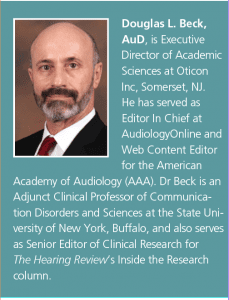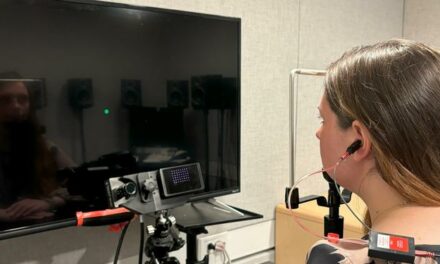Inside the Research | January 2019 Hearing Review
Jason Galster, PhD, is known in our field as an excellent researcher, educator, and author. He worked at Starkey Hearing Technologies for many years as senior manager of audiology research, after having served as a pediatric and a research audiologist looking into topics like digital signal processing, physical room acoustics, and amplification in hearing impaired pediatric populations. More recently, Dr Galster became the director of clinical research at Advanced Bionics, headquartered in Valencia, Calif, and has authored the book, Audiology Treatment (Thieme Medical Publishers, 2018),1 which belongs to a three-part book series that focuses on audiology treatment, diagnosis, and practice management, respectively. I thought it would be a good time to catch up with Dr Galster and review several of the topics covered in the new book.
Beck: Good morning, Jason. Congratulations on the new book!
Galster: Hi Doug. Thanks. I appreciate your interest.
Beck: I should note that this book has a legacy, in that the series was started by Michael Valente, Ross J. Roeser, and Holly Hosford-Dunn, and is now in its 3rd edition. The original editors are handing off the project to other talented writers and scientists?
Galster: Exactly. I was honored to be picked by Dr Valente to carry on as the new editor for Audiology Treatment, which was his project for the first two editions. I’ve always respected Michael, and when he invited me to step into his shoes and carry the torch forward, I was honored to accept.
Beck: Absolutely. And for the readers who may not have seen the book yet, at the end of this interview, there’s a PDF in the online version of this article with all the chapter titles and the authors—a stellar cast with essentially new and cutting-edge insights into many topics related to clinical audiology.
Galster: Thanks Doug. As you mentioned, these authors are enormously talented. The chapters span a wide array of topics: acoustic and bone-conduction hearing aids, cochlear implants, assistive listening devices, hearing protection, and tinnitus management.
Beck: OK, let’s jump into a few clinical areas and questions that occurred to me while reading the book. I noticed in the preface you joyfully started at the beginning of the patient encounter—which is not necessarily otoscopy and pure tones—but is, more appropriately, a communication or listening assessment, delving into the difficulties the patient is having and their specific needs. As every audiologist knows, the fact that someone has a hearing loss as demonstrated or evidenced on an audiogram does not mean they have a problem or that they need hearing aids. That determination comes about secondary to evaluating how their hearing loss impacts their life.
Galster: Yes, I agree. As audiologists, we can be hyperfocused on diagnostic models of work, which demands we churn through air, bone, and speech measures to support medical diagnoses and treatment plans. However, as Doctors of Audiology, we also need to focus hearing care around our patients and the demands of their daily lives, beginning with a needs assessment, complemented by measurement of post-treatment outcomes, validating the effectiveness of our treatment. These elements of needs assessment and outcome measurement are guideposts along the patient’s journey that are addressed in detail over multiple chapters in the textbook.
Beck: And, of course, the number one problem reported by people with hearing aids and people with untreated hearing loss is the inability to understand speech in noise (SIN). To that point, I recall you wrote in March 2018 that an established goal of modern hearing aids is to improve speech understanding for the wearer—and this goal is best achieved by improving the signal-to-noise ratio (SNR).2
Galster: That’s correct. Good memory. And Doug, as you’ve written a few times, the typical hearing care professional doesn’t measure speech understanding in noise, so they don’t have that needs assessment to explain how much SNR improvement a patient needs. This point alone is an important topic for counseling, and one that many of us have identified as critically important to meeting the needs of the patient—and one that is in accordance with our professional best practice guidelines.
Beck: Dr Valente and I published an article3 in the December 2017 Hearing Review in which we discussed the need (and gross under-utilization) for SIN testing, and, of note,—as Michael was the lead author for both AAA and ASHA best practice statements4,5—this is not a new idea or topic. That is, both best practice statements urge real-ear measurements and speech-in-noise tests to assure that verification and validation have occurred appropriately.
Galster: That seems like a highly rationale position! I agree with everything you just said. Our first goal is understanding the patient’s handicap, their lifestyle, their expectations, their subjective needs, and their definition of success. One might argue that it’s our responsibility to explore and define the problem the patient perceives, before engaging a test protocol.
Beck: I agree entirely. If we simply use generic diagnostic tests, and we don’t tailor them to explore the patient’s chief complaint, we may come up with an excellent diagnosis, and a perfectly reasonable treatment for that diagnosis, but the patient may still have the problem which brought them in, which is most often SIN. Jason, which communication and listening assessment tools are among the most important?
Galster: I like the Client Oriented Scale of Improvement (COSI)6 as the standard because it is open-ended and allows us to really dig into the patient’s issues, while setting goals that define success from the patient’s perspective. Of course, there are many other useful tools, too, like the Abbreviated Profile of Hearing Aid Benefit (APHAB),7 the Hearing Handicap Inventory for Adults (HHIA)8 and for the Elderly (HHIE),9 as well as the International Outcome Inventory (IOI-HA),10 and more, which are detailed in the book, too.
Beck: And, of note, these tools are available in multiple languages. Specifically, the IOI-HA is rather quick; it takes about 5 to 10 minutes to complete…and it’s built on a simple Likert scale, so it’s fast and intuitive, and identifies the patient’s needs—prior to testing.
This brings me to a very specific question. Admittedly, I know you covered this in your “soon-to-be-a-classic” 2011 article.11 Nonetheless, I get this question at least once a month and your answer was excellent. So, what’s the difference between a band and a channel?
Galster: Yes, I get that a lot, too. A hearing aid channel is the range of frequencies created by a digital filter(s) within the hearing aid. These channels are where the signal processing occurs, such as expansion, compression, digital noise reduction, and feedback suppression. Bands, on the other hand, are defined by the programming software and can be interpreted as the “handles” available to the practitioner for adjustment of the hearing aid frequency response.
Beck: Excellent. Let’s jump to one of today’s hottest technology topics and talk about the predominate wireless protocols used in hearing devices, which I would argue are 2.4 GHz and NFMI. Can you shed some light on these?
Galster: Certainly. The wireless subsystems in hearing devices have become increasingly important and have converged, more or less, on two approaches that operate in low- and high-frequency ranges.
The lower frequency system—in the range of 10 MHz—is called Near-Field Magnetic Induction (NFMI) and is most commonly used to establish an ear-to-ear connection between bilateral hearing devices. The lower frequency signals travel more easily through and around the head, allowing for real-time communication at impressively high data rates. Generally, when NFMI is used for ear-to-ear communication in hearing aids, cochlear implants, and bone conductors, the energy demands (battery drain) are quite low. The disadvantage to NFMI is that it has a short transmission distance. However, for ear-to-ear use, that’s not a problem, and it remains a good option for demanding bi-directional data exchange, such as that used in binaural beamforming, ear-to-ear audio transmission, and signal analysis.
The higher frequency system, 2.4 GHz, is often attributed to Bluetooth (BT), but it may not actually be BT. At 2.4 GHz, signals can be transmitted over long distances, facilitating connection from the hearing device to a cell phone or another device (eg, tablet, phone, computer, etc). In today’s hearing devices, there are three commonly used 2.4 GHz protocols: the first is BT Low Energy which is used for programming and/or data exchange; the second is a more “classic” version of BT that can carry audio and data, and the third is usually proprietary, used to transmit audio with very low latency and low power consumption (imagine a TV adapter that transmits directly to hearing devices). These are all 2.4 GHz signals but only a subset are accurately described as “Bluetooth.”
Beck: Thanks. I doubt most of us are well-versed in these matters, which, of course, does support the need to acquire your new book!
Let’s look at another lesser known feature which can be used in contemporary hearing aids. Can you please discuss “geotagging?” And, by way of a heads-up, we’re talking about the ability to geographically “tag” a location.
Galster: Right. If the hearing device has geotagging ability, it allows the wearer to say “when I am here, do this or do that.” The implications of geotagging (and/or geofencing) are vast. Let’s start with the fact that using GPS is already in smartphones and now allows us to associate phone settings and memories with specific locations. So you might want to set a coffee shop program, or an airport location, or a quiet room location…and when the phone registers and identifies that location, it pushes a program change to the hearing aid, based on the user’s self-adjusted preference for that acoustic environment.
As we move forward in developing contemporary hearing devices, the application of these abilities will increase tremendously.
Beck: And so, in a noisy coffee shop you might want your noise reduction and directional or multi-speaker access technology to reset to maximum, but while walking in the park, you may want to turn off all automatics and default to low gain with omni?
Galster: That’s exactly right. The options and outcomes are almost limitless. As we use geotags to identify and manage the sound processing of the hearing aids, the hearing aids become more app dependent, but also more situationally applied and fine-tuned to the user’s preferences in that specific environment.
Beck: Thanks Jason. I want to thank you for your time and wish you tremendous success with the new book. I think it’s apparent that, as hearing aids, cochlear implants, apps, and remote microphones become more sophisticated and intertwined, we’ll need to stay on top of these technologies and maintain our positions and responsibilities as doctors and clinicians. And, the new book holds our hands as we get deeper into this technology, makes it easy to understand, and significantly adds to our knowledge base.
Galster: Thanks, Doug! As always, it was great to chat. I appreciate your interest in the book and look forward to seeing you in 2019.
About the Author: Douglas L. Beck, AuD, is Executive Director of Academic Sciences at Oticon Inc, Somerset, NJ. He has served as Editor In Chief at AudiologyOnline and Web Content Editor for the American Academy of Audiology (AAA). Dr Beck is an Adjunct Clinical Professor of Communication Disorders and Sciences at the State University of New York, Buffalo, and also serves as Senior Editor of Clinical Research for The Hearing Review’s Inside the Research column.
CORRESPONDENCE to Dr Beck at: [email protected]
Citation for this article: Beck DL. Outcome measures, wireless technologies, and more: An interview with Jason Galster, PhD. Hearing Review. 2019;26(1):24-26.
References
-
Galster JA. Audiology Treatment. 3rd Ed. New York, NY: Thieme Medical Publishers;2018.
-
Goyette A, Crukley J, Galster J. The effects of varying directional bandwidth in hearing aid users’ preference and speech-in-noise performance. Am J Audiol.2018;27(1):95-103.
-
Beck DL. Best practices in hearing aid dispensing: An interview with Michael Valente, PhD. Hearing Review. 2017;24(12):39-41.
-
Valente M, Abrams H, Benson D, et al. American Academy of Audiology Task Force. Guidelines for the audiologic management of adult hearing impairment. https://audiology-web.s3.amazonaws.com/migrated/haguidelines.pdf_53994876e92e42.70908344.pdf. Published 2006.
-
Valente M, Barninger KH, Oeding K, et al. American Academy of Audiology. American Academy of Audiology clinical practice guidelines: Adult patients with severe-to-profound unilateral sensorineural hearing loss. https://www.audiology.org/sites/default/files/PractGuidelineAdultsPatientsWithSNHL.pdf. Published June 6, 2015.
-
Dillon H, James A, Ginis J. Client Oriented Scale of Improvement (COSI) and its relationship to several other measures of benefit and satisfaction provided by hearing aids. J Am Acad Audiol.1997;8:27-43.
-
Cox RM, Alexander GC. The Abbreviated Profile Of Hearing Aid Benefit. Ear Hear.1995;16(2):176-186.
-
Newman CW, Weinstein BE, Jacobson GP, Hug GA. The Hearing Handicap Inventory for Adults: Psychometric adequacy and audiometric correlates. Ear Hear.1990;11(6):430-433.
-
Ventry IM, Weinstein BE. The Hearing Handicap Inventory for the Elderly: A new tool. Ear Hear.1982;3(3):128-134.
-
Cox RM, Alexander GC. The International Outcome Inventory for Hearing Aids (IOI-HA):Psychometric properties of the English version. Int J Audiol. 2002;41:30-35.
-
Galster J, Galster EA. The value of increasing the number of channels and bands in a hearing aid. Available at: https://www.audiologyonline.com/articles/value-increasing-number-channels-and-826. June 13, 2011.








